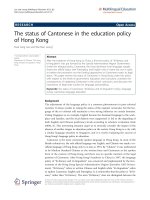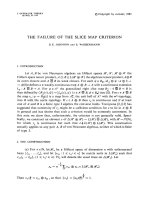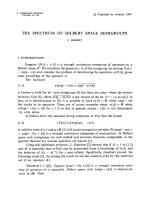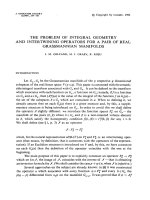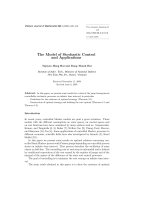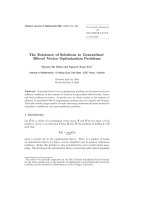Báo cáo toán học: "The sum of degrees in cliques" doc
Bạn đang xem bản rút gọn của tài liệu. Xem và tải ngay bản đầy đủ của tài liệu tại đây (104.12 KB, 10 trang )
The sum of degrees in cliques
B´ela Bollob´as
∗†‡
and Vladimir Nikiforov
∗
Submitted: Sep 10, 2004; Accepted: Nov 1, 2005; Published: Nov 7, 2005
Mathematics Subject Classifications: 05C35
Abstract
For every graph G, let
∆
r
(G)=max
u∈R
d (u):R is an r-clique of G
and let ∆
r
(n, m) be the minimum of ∆
r
(G) taken over all graphs of order n and
size m.Writet
r
(n)forthesizeofther-chromatic Tur´an graph of order n.
Improving earlier results of Edwards and Faudree, we show that for every r ≥ 2,
if m ≥ t
r
(n) , then
∆
r
(n, m) ≥
2rm
n
, (1)
as conjectured by Bollob´as and Erd˝os.
It is known that inequality (1) fails for m<t
r
(n) . However, we show that for
every ε>0, there is δ>0 such that if m>t
r
(n) − δn
2
then
∆
r
(n, m) ≥ (1 − ε)
2rm
n
.
1 Introduction
Our notation and terminology are standard (see, e.g. [1]): thus G (n, m) stands for a
graph of n vertices and m edges. For a graph G and a vertex u ∈ V (G) , we write Γ (u)
for the set of vertices adjacent to u and set d
G
(u)=|Γ(u)|; we write d (u) instead of
d
G
(u) if the graph G is understood. However, somewhat unusually, for U ⊂ V (G) , we
set
Γ(U)=|∩
v∈U
Γ(v)| and
d (U)=
Γ(U)
.
We write T
r
(n) for the r-chromatic Tur´an graph on n vertices and t
r
(n) for the number
of its edges.
∗
Department of Mathematical Sciences, University of Memphis, Memphis TN 38152, USA
†
Trinity College, Cambridge CB2 1TQ, UK
‡
Research supported in part by DARPA grant F33615-01-C-1900.
the electronic journal of combinatorics 12 (2005), #N21 1
For every r ≥ 2 and every graph G, let ∆
r
(G) be the maximum of the sum of degrees
of the vertices of an r-clique, as in the abstract. If G has no r-cliques, we set ∆
r
(G)=0.
Furthermore, let
∆
r
(n, m)= min
G=G(n,m)
∆
r
(G) .
Since T
r
(n)isaK
r+1
-free graph, it follows that ∆
r
(n, m) = 0 for m ≤ t
r−1
(n) . In
1975 Bollob´as and Erd˝os [2] conjectured that for every r ≥ 2, if m ≥ t
r
(n) , then
∆
r
(n, m) ≥
2rm
n
. (2)
Edwards [3], [4] proved (2) under the weaker condition m>(r − 1) n
2
/2r;healso
proved that the conjecture holds for 2 ≤ r ≤ 8andn ≥ r
2
. Later Faudree [7] proved the
conjecture for any r ≥ 2andn>r
2
(r −1) /4.
For t
r−1
(n) <m<t
r
(n)thevalueof∆
r
(n, m) is essentially unknown even for r =3
(see [5], [6] and [7] for partial results.) A construction due to Erd˝os and Faudree (see [7],
Theorem 2) shows that, for every ε>0, there exists δ>0 such that if t
r−1
(n) <m<
t
r
(n) −δn
2
then
∆
r
(n, m) ≤ (1 −ε)
2rm
n
.
The construction is determined by two appropriately chosen parameters a and d and
represents a complete (r − 1)-partite graph with (r −2) chromatic classes of size a and a
d-regular bipartite graph inserted in the last chromatic class.
In this note we prove a stronger form of (2) for every r and n. Furthermore, we prove
that ∆
r
(n, m)is“stable”asm approaches t
r
(n) . More precisely, for every ε>0, there
is δ>0 such that if m>t
r
(n) −δn
2
then
∆
r
(n, m) ≥ (1 −ε)
2rm
n
for n sufficiently large.
1.1 Preliminary observations
If M
1
, , M
k
are subsets of a (finite) set V then
∩
k
i=1
M
i
≥
k
i=1
|M
i
|−(k − 1) |V |. (3)
The size t
r
(n)oftheTur´an graph T
r
(n)isgivenby
t
r
(n)=
r −1
2r
n
2
−
s
2
1 −
s
r
.
where s is the remainder of n modulo r. Hence,
r −1
2r
n
2
−
r
8
≤ t
r
(n) ≤
r − 1
2r
n
2
. (4)
the electronic journal of combinatorics 12 (2005), #N21 2
2 A greedy algorithm
In what follows we shall identify a clique with its vertex set.
Faudree [7] introduced the following algorithm P to construct a clique {v
1
, , v
k
} in
agraphG:
Step 1: v
1
is a vertex of maximum degree in G;
Step 2: having selected v
1
, , v
i−1
, if
Γ(v
1
, , v
i−1
)=∅ then set k = i −1andstopP,
otherwise P selects a vertex of maximum degree v
i
∈
Γ(v
1
, , v
i−1
) and step 2 is repeated
again.
Faudree’s main reason to introduce this algorithm was to prove Conjecture (2) for n
sufficiently large, so he did not study P in great detail. In this section we shall establish
some properties of P for their own sake. Later, in Section 3, we shall apply these results
to prove an extension of (2) for every n.
Note that P need not construct a unique sequence. Sequences that can be constructed
by P are called P-sequences; the definition of P implies that
Γ(v
1
v
k
)=∅ for every
P-sequence v
1
, , v
k
.
Theorem 1 Let r ≥ 2,n≥ r and m ≥ t
r
(n). Then every graph G = G (n, m) is such
that:
(i) every P-sequence has at least r terms;
(ii) for every P-sequence v
1
, , v
r
, ,
r
i=1
d (v
i
) ≥ (r − 1) n;(5)
(iii) if equality holds in (5) for some P-sequence v
1
, , v
r
, then m = t
r
(n).
Proof Without loss of generality we may assume that P constructs exactly the vertices
1, , k and hence d (1) ≥ ≥ d (k).
Proof of (i) and (ii) To prove (i) we have to show that k ≥ r. For every i =1, , k,
let M
i
=Γ(i) ; clearly,
k
i=1
d (i) ≤ (q − 1)n,
since, otherwise, (3) implies that
Γ(v
1
v
k
) = ∅, and so 1, , k is not a P-sequence,
contradicting the choice of k. Suppose k<r,andletq be the smallest integer such that
the inequality
h
i=1
d (i) > (h −1) n (6)
holds for h =1, , q −1, while
q
i=1
d (i) ≤ (q − 1)n. (7)
the electronic journal of combinatorics 12 (2005), #N21 3
Clearly, 1 <q≤ k.
Partition V = ∪
q
i=1
V
i
, so that
V
1
= V \Γ(1),
V
i
=
Γ([i −1]) \
Γ([i]) for i =2, , q − 1,
V
q
=
Γ([q − 1]) .
We have
2m =
j∈V
d (j)=
q
h=1
j∈V
h
d (j) ≤
q
i=1
d (i) |V
i
|
= d (1) (n − d (1)) +
q−1
i=2
d (i)
d ([i −1]) −
d ([i])
+ d (q)
d ([q − 1])
= d (1) n +
q−1
i=1
d ([i]) (d (i +1)− d (i)) . (8)
For every i ∈ [q − 1] , set k
i
= n − d (i)andletk
q
= n − (k
1
+ + k
q−1
) . Clearly,
k
i
> 0 for every i ∈ [q]; also, k
1
+ + k
q
= n.
Furthermore, for every h ∈ [q − 2] , applying (3) with M
i
=Γ(i), i ∈ [h] , and (6), we
see that,
d ([h]) =
Γ([h])
≥
h
i=1
d (i) −(h − 1) n = n −
h
i=1
k
i
> 0.
Hence, by d (h +1)≤ d (h) , it follows that
d ([h]) (d (h +1)− d (h)) ≤
n −
h
i=1
k
i
(d (h +1)− d (h)) . (9)
Since, from (7), we have
d (q) ≤ (q − 1) n −
q−1
i=1
d (i)=
q−1
i=1
k
i
, (10)
in view of (9) with h = q − 1, it follows that
d ([q − 1]) (d (q) − d (q −1)) ≤
n −
q−1
i=1
k
i
(d (q) −d (q − 1))
≤
n −
q−1
i=1
k
i
q−1
i=1
k
i
− d (q −1)
.
the electronic journal of combinatorics 12 (2005), #N21 4
Recalling (8) and (9), this inequality implies that
2m ≤ nd (1) +
q−2
h=1
n −
h
i=1
k
i
(d (h +1)− d (h))
+
n −
q−1
i=1
k
i
q−1
i=1
k
i
− d (q −1)
.
Dividing by 2 and rearranging the right-hand side, we obtain
m ≤
n −
q−1
i=1
k
i
q−1
i=1
k
i
+
1≤i<j≤q−1
k
i
k
j
=
1≤i<j≤q
k
i
k
j
. (11)
Note that
1≤i<j≤q
k
i
k
j
= e (K (k
1
, , k
q
)) .
Given n and k
1
+ + k
q
= n, the value e (K (k
1
, , k
q
)) attains its maximum if and only
if all k
i
differbyatmost1, that is to say, when K (k
1
, , k
q
)isexactlytheTur´an graph
T
q
(n) . Hence, the inequality m ≥ t
r
(n) and (11) imply
t
r
(n) ≤ m ≤ e (K (k
1
, , k
q
)) ≤ t
q
(n) . (12)
Since q<r≤ n implies t
q
(n) <t
r
(n) , contradicting (12), the proof of (i) is complete.
To prove (ii) suppose (5) fails, i.e.,
r
i=1
d (i) < (r −1) n.
Hence, (10) holds with a strict inequality and so, the proof of (12) gives t
r
(n) <t
r
(n) .
This contradiction completes the proof of (ii).
Proof of (iii) Suppose that for some P-sequence v
1
, , v
r
, equality holds in (5). We
may and shall assume that v
1
, , v
r
=1, , r, i.e.,
r
i=1
d (i)=(r −1) n.
Following the arguments in the proof of (i) and (ii), from (12) we conclude that
t
r
(n) ≤ m ≤ t
r
(n) .
and this completes the proof.
the electronic journal of combinatorics 12 (2005), #N21 5
3 Degree sums in cliques
In this section we turn to the problem of finding ∆
r
(n, m) for m ≥ t
r
(n) . We shall apply
Theorem 1 to prove that every graph G = G (n, m)withm ≥ t
r
(n)containsanr-clique
R with
i∈R
d (i) ≥
2rm
n
. (13)
As proved by Faudree [7], the required r-clique R may be constructed by the algorithm P.
Note that the assertion is trivial for regular graphs; as we shall show, if G is not regular,
we may demand strict inequality in (13).
Theorem 2 Let r ≥ 2,n≥ r, m ≥ t
r
(n) and let G = G (n, m) be a graph which is not
regular. Then there exists a P-sequence v
1
, , v
r
, of at least r termssuchthat
r
i=1
d (v
i
) >
2rm
n
.
Proof Part (iii) of Theorem 1 implies that for some P-sequence, say 1, , r, , we have
r
i=1
d (i) > (r −1) n.
Since d (i) <n,we immediately obtain
s
i=1
d (i) > (s −1) n (14)
for every s ∈ [r] .
The rest of the proof consists of two parts: In part (a) we find an upper bound for m
in terms of
r
i=1
d (i)and
r
i=1
d
2
(i) . Then, in part (b), we prove that
1
r
r
i=1
d (i) ≥
2m
n
,
and show that if equality holds then G is regular.
(a) Partition the set V into r sets V = V
1
∪ ∪ V
r
, where,
V
1
= V \Γ(1),
V
i
=
Γ([i − 1]) \
Γ([i]) for i =2, , r − 1,
V
r
=
Γ([r −1]) .
the electronic journal of combinatorics 12 (2005), #N21 6
We have,
2m =
i∈V
d (i)=
r
h=1
j∈V
h
d (j) ≤
r
i=1
d (i) |V
i
|
=
r−1
i=1
(d (i) −d (r)) |V
i
| + nd (r) (15)
Clearly, for every i ∈ [r − 1] , from (3), we have
Γ([i +1])
≥
Γ([i])
+ |Γ(i +1)|−n =
Γ([i])
+ d (i +1)− n
and hence, |V
i
|≤n − d (i) holds for every i ∈ [r −1] . Estimating |V
i
| in (15) we obtain
2m ≤
r−1
i=1
(d (i) −d (r)) (n −d (i)) + nd (r)
= n
r
i=1
d (i) −
r
i=1
d
2
(i)+d (r)
r
i=1
d (i) −n (r − 1)
.
(b) Let S
r
=
r
i=1
d (i) . From d (r) ≤ S
r
/r and Cauchy’s inequality we deduce
2m ≤ nS
r
−
r
i=1
d
2
(i)+
S
r
r
(S
r
− (r − 1)n)
≤ nS
r
−
1
r
(S
r
)
2
+
S
r
r
(S
r
− (r − 1) n) ≤
nS
r
r
,
and so,
r
i=1
d (i) ≥
2rm
n
. (16)
To complete the proof suppose we have an equality in (16). This implies that
r
i=1
d
2
(i)=
1
r
r
i=1
d (i)
2
and so, d (1) = = d (r) . Therefore, the maximum degree d (1) equals the average degree
2m/n, contradicting the assumption that G is not regular.
Since for every m ≥ t
r
(n) there is a graph G = G (n, m) whose degrees differ by at
most 1, we obtain the following bounds on ∆
r
(n, m) .
Corollary 1 For every m ≥ t
r
(n)
2rm
n
≤ ∆
r
(n, m) <
2rm
n
+ r.
the electronic journal of combinatorics 12 (2005), #N21 7
4 Stability of ∆
r
(n, m) as m approaches t
r
(n)
It is known that inequality (2) is far from being true if m ≤ t
r
(n) − εn for some ε>0
(e.g., see [7]). However, it turns out that, as m approaches t
r
(n) , the function ∆
r
(n, m)
approaches 2rm/n. More precisely, the following stability result holds.
Theorem 3 For every ε>0 there exist n
0
= n
0
(ε) and δ = δ (ε) > 0 such that if
m>t
r
(n) −δn
2
then
∆
r
(n, m) > (1 −ε)
2rm
n
for all n>n
0
.
Proof Without loss of generality we may assume that
0 <ε<
2
r (r +1)
.
Set
δ = δ (ε)=
1
32
ε
2
.
If m ≥ t
r
(n) , the assertion follows from Theorem 2, hence we may assume that
2rm
n
<
2rt
r
(n)
n
≤ (r − 1) n.
Clearly, our theorem follows if we show that m>t
r
(n) −δn
2
implies
∆
r
(n, m) > (1 −ε)(r −1) n (17)
for n sufficiently large.
Suppose the graph G = G (n, m)satisfiesm>t
r
(n)−δn
2
. By (4), if n is large enough,
m>t
r
(n) −δn
2
>
r −1
2r
− δ
n
2
−
r
8
≥
r −1
2r
− 2δ
n
2
. (18)
Let M
ε
⊂ V be defined as
M
ε
=
u : d (u) ≤
r −1
r
−
ε
2
n
.
The rest of the proof consists of two parts. In part (a) we shall show that |M
ε
| <εn,
and in part (b) we shall show that the subgraph induced by V \M
ε
contains an r-clique
with large degree sum, proving (17).
(a) Our first goal is to show that |M
ε
| <εn.Indeed, assume the opposite and select
an arbitrary M
⊂ M
ε
satisfying
1
2
−
1
2
√
2
εn < |M
| <
1
2
+
1
2
√
2
εn. (19)
the electronic journal of combinatorics 12 (2005), #N21 8
Let G
be the subgraph of G induced by V \M
. Then
e (G)=e (G
)+e (M
,V\M
)+e (M
) ≤ e (G
)+
u∈M
d (u) (20)
≤ e (G
)+|M
|
r − 1
r
−
ε
2
n.
Observe that second inequality of (19) implies
n −|M
| > (1 −ε) n.
Hence, if
e (G
) ≥
r − 1
2r
(n −|M
|)
2
then, applying Theorem 2 to the graph G
,weseethat
∆
r
(G) ≥ ∆
r
(G
) ≥
2re (G
)
n −|M
|
≥ (r − 1) (n −|M
|) > (r − 1) (1 − ε) n,
and (17) follows. Therefore, we may assume
e (G
) <
r − 1
2r
(n −|M
|)
2
.
Then, by (18) and (20),
r −1
2r
(n −|M
|)
2
>e(G
) > −|M
|
r −1
r
−
ε
2
n +
r − 1
2r
− 2δ
n
2
.
Setting x = |M
|/n, this shows that
r − 1
2r
(1 −x)
2
+ x
r −1
r
−
ε
2
−
r −1
2r
− 2δ
> 0,
which implies that
x
2
− εx +4δ>0.
Hence, either
|M
| >
ε −
√
ε
2
− 16δ
2
n =
1
2
−
1
2
√
2
εn
or
|M
| <
ε +
√
ε
2
− 16δ
2
=
1
2
+
1
2
√
2
εn,
contradicting (19). Therefore, |M
ε
| <εn,as claimed
(b) Let G
0
be the subgraph of G induced by V \M
ε
. By the definition of M
ε
, if u ∈
V \M
ε
, then
d
G
(u) >
r −1
r
−
ε
2
n,
the electronic journal of combinatorics 12 (2005), #N21 9
and so
d
G
0
(u) >
r −1
r
−
ε
2
n −|M
ε
| >
r − 2
r − 1
(n −|M
ε
|) .
Hence, by Tur´an’s theorem, G
0
contains an r-clique and, therefore,
∆
r
(G) >r
r − 1
r
−
ε
2
n ≥ (1 −ε)(r −1) n,
proving (17) and completing the proof of our theorem.
Acknowledgement. The authors are grateful to Prof. D. Todorov for pointing out
a fallacy in an earlier version of the proof of Theorem 2 and to the referee for his valuable
suggestions.
Added on July 1st, 2005. The results of this paper were first presented in a seminar
at Memphis University in February, 2002 and also form part of the second author’s Ph.D.
thesis [10], Ch. 7. The results in Theorems 1 and 2 were reproduced by Khadzhiivanov
and Nenov in [8], [9].
References
[1] B. Bollob´as, Modern Graph Theory, Graduate Texts in Mathematics 184, Springer
Verlag, 1998, xiv–394pp.
[2] B. Bollob´as and P. Erd˝os, Unsolved problems, Proc. Fifth Brit. Comb. Conf. (Univ.
Aberdeen, Aberdeen, 1975), Winnipeg, Util. Math. Publ., 678–680.
[3] C. Edwards, The largest vertex degree sum for a triangle in a graph, Bull. Lond.
Math. Soc., 9 (1977), 203–208.
[4] C. Edwards, Complete subgraphs with largest sum of vertex degrees, Combinatorics
(Proc. Fifth Hungarian Colloq., Keszthely, 1976), Vol. I, Colloq. Math. Soc. J´anos
Bolyai, 18, North-Holland, Amsterdam-New York, 1978, pp. 293–306.
[5] P. Erd˝os and R. Laskar, On maximum chordal subgraph, Proceedings of the four-
teenth Southeastern conference on combinatorics, graph theory and computing (Boca
Raton, Fla., 1983). Congr. Numer. 39 (1983), 367–373.
[6] G. Fan, Degree sum for a triangle in a graph, J. Graph Theory 12 (1988), 249–263.
[7] R. Faudree, Complete subgraphs with large degree sums, J. Graph Theory 16 (1992),
327–334.
[8] N. Khadzhiivanov and N. Nenov, Sequences of maximal degree vertices in graphs,
Serdica Math. J. 30 (2004), 95–102.
[9] N. Khadzhiivanov and N. Nenov, Saturated β-sequences in graphs, C. R. Acad.
Bulgare Sci. 57 (2004), 49–54.
[10] V. Nikiforov, Stability results in extremal graph theory, PhD thesis, Inst. of Math.
and Inform., Bul. Acad. Sci., Sofia.
the electronic journal of combinatorics 12 (2005), #N21 10

